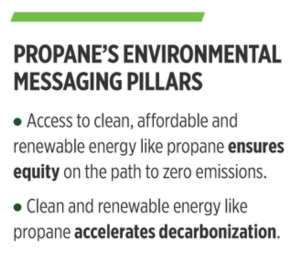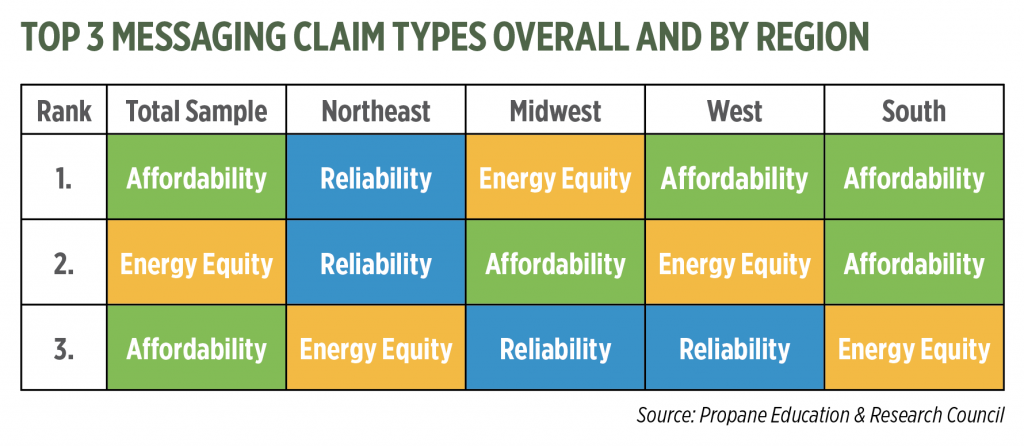Environmental playbook challenges propane marketers to lead a grassroots campaign
You’re reading part two of a three-part series about the propane industry’s new environmental messaging campaign. Read part one and three.
Judy Taranovich runs a retail propane operation of 14 employees out of Vermont, where she says the electrification movement has come “fast and furious.”
Vermont’s state law requires an incremental reduction of greenhouse gas emissions to 80 percent below 1990 levels by 2050, and allows individuals to sue the state if goals aren’t met. Taranovich says the state is in an “electric sweet spot” where grant money and rebates are funding electric vehicles, charging stations, solar panels and heat pumps.
It’s a problem with which Taranovich has been contending for a long time now – and one that’s spreading. She says Vermont’s electrify-everything approach has been a forerunner to similar policies and practices now common throughout New England.
“We probably could have had a better shot getting ahead of this five years ago,” she explains. “With that said, there’s always hope.”
For Taranovich, only an “all hands on deck” approach will change the trajectory of the electrification movement at this late stage.
But it’s a big country, and the propane industry’s markets and customers are just as diverse. Not all regions, or even municipalities, are dealing with the same challenges.
That’s why the industry’s environmental messaging campaign jointly developed by the National Propane Gas Association (NPGA) and the Propane Education & Research Council (PERC) has attempted to account for regional and local differences in energy policy and consumer sentiment, while underscoring the same core messages everywhere propane is sold.
Educating consumers
When John Jessup, president and CEO of the North Carolina Propane Gas Association (NCPGA), parks his propane-powered vehicle, emblazoned with a clean and green message, in downtown Raleigh, he says young people tend to dispute that propane is clean because it’s a fossil fuel. It’s a good opportunity, says Jessup, to start a conversation about propane’s positive attributes, including that it’s not a greenhouse gas.
He thinks PERC’s state engagement program will also start conversations in a politically purple state that is hotly debating its clean-energy future. The PERC program supports digital media buys by providing $2 for every $1 invested by state and regional associations.
The media assets were tested in each of the four U.S. regions – Northeast, South, Midwest and West – in an effort to tailor the messages to the unique interests of the region. The new environmental campaign’s core messages – that propane accelerates decarbonization and ensures equity on the path to net-zero emissions – were each broken down into sub-messages for testing. Also included in the testing were messages focusing on propane’s attributes of affordability, versatility and reliability.
The tests targeted current and prospective propane users in propane country, and resonated with the concerns of younger generations (18- to 40-year-olds), who present a major growth opportunity for the industry, says Erin Hatcher, senior vice president of communications and marketing at PERC, during a webinar about propane’s new identity.
Testing showed that, across the board, messages emphasizing affordability and energy equity resonated best with consumers in propane country. Reliability also ranked well on a regional basis, particularly in the Northeast. Overall, hard-hitting environmental messages ranked in the top 12 of about 50 messages but did not make the top 5, Hatcher explains.
This result points toward a discrepancy in the way consumers think about the environment and how they act, explains Tucker Perkins, president and CEO of PERC. Consumers may say they’re concerned about environmental attributes – especially in the context of policy, codes or standards – but may be more concerned about affordability and reliability when it comes to choosing energy for their homes.
“At some point, consumers still really value things like efficiency and cost and warmth and comfort and reliability,” says Perkins.
Taranovich observes this dynamic even in Vermont. While policymakers advance electrification agendas, homeowners may not be aware of the ramifications of those policies, she says. She sees that knowledge gap as an opening to educate customers about the importance of a diverse range of energy sources for security, reliability, affordability and stewardship of the environment.
“I think it’s important for each and every marketer to get the word out, whether it’s stuffers in their statements, making phone calls, putting it in newsletters, putting something up on their websites; they have to get this message out in front of each and every consumer to let them know that their choice of fuel is being taken away from them,” says Taranovich.
Gaining fluency
Even in locales where consumers don’t demand an environmental focus, the pillars of decarbonization and energy equity remain foundational to an effective grassroots campaign, say industry leaders. After all, today’s consumers comprise just one of several key audiences marketers must reach.
 “You have to know your audience. A lot of customers today aren’t asking [retailers] to be fluent,” says Perkins. “But when you talk to your congressman, you probably need to be fluent. When you talk to your building inspector, you probably need to be fluent. When you talk to your newspaper editor, you probably need to be fluent. When you talk to your rotary club, you should be fluent. Because we’re not really in business just for today. We’re in business for the next generation, too, and the next generation of our customers.”
“You have to know your audience. A lot of customers today aren’t asking [retailers] to be fluent,” says Perkins. “But when you talk to your congressman, you probably need to be fluent. When you talk to your building inspector, you probably need to be fluent. When you talk to your newspaper editor, you probably need to be fluent. When you talk to your rotary club, you should be fluent. Because we’re not really in business just for today. We’re in business for the next generation, too, and the next generation of our customers.”
The industry’s environmental messaging campaign is designed to give marketers a framework of vocabulary to engage fluently with all stakeholders about propane’s role in a clean energy future.
If marketers don’t speak the language of decision-makers who are embroiled in energy policy, for instance, those decision-makers will quickly write them off, says Sarah McLallen, vice president of communications and member services at NPGA, in a webinar about the industry’s new brand.
But those conversations are critical to propane’s future. About 50 cities have already banned natural gas and propane, and another 50 cities are considering it, reports McLallen.
Propane marketers, who often run small to midsized businesses, are uniquely equipped to tell propane’s story on the local level and reverse those trends.
“People don’t want to talk about big corporations based in another state,” says McLallen. “They want to talk to you. They know you. They see you in the community.
“It’s hard to put someone you know out of business,” she adds.
Points of emphasis in those conversations vary by location. For example, renewable propane is a focal point for the propane industry in California, where localities are divesting themselves from fossil fuels.
“From the governor to the legislature to the regulatory agencies, that movement is well underway and heavily funded,” says Joy Alafia, president and CEO of the Western Propane Gas Association (WPGA). “Thankfully, we have an affordable, renewable solution that integrates with the narrative of policymakers as they seek sustainable solutions.”
WPGA has set a goal of providing 100 percent renewable propane to California by 2030 and has sponsored a bill that would provide financial incentives for its production.
Throughout the Midwest and South, the industry’s engagement with state lawmakers has supported legislation that defends consumers’ right to choose energy sources. As of mid-July, Missouri was the latest of nearly 20 states to pass a consumer choice bill, and North Carolina is one of several more with a high chance of success in 2021, reports NPGA.
Sharing aspirations
Another reason marketers benefit from gaining fluency in clean energy debates is that environmental concerns will only grow as the younger generations assume more responsibilities.
Millennials comprise the first generation exposed to an international dialogue about climate and the environment, explains Hatcher in a webinar about the need to rebrand.
“They’ll vote with their pocketbooks,” Hatcher explains. “They boycott companies that don’t support these goals and initiatives.”
In California, that means talking about the benefits of propane today while simultaneously working toward a renewable component.
“We’re going to put us in the conversation along with all other renewable solutions that aren’t at commercial mass yet,” explains Alafia. “The goal is carbon neutrality, and we all have a lane or a role to play. We’re going to talk about that timeline right alongside wind, right alongside solar – and the added benefit of how we can do that more cost-effectively than probably any other renewable solution.”
In areas where renewable propane isn’t economically feasible yet, marketers can still help fulfill propane’s promise as a fuel of the future. They can talk about how a diverse range of energy sources, including propane, can help ensure energy security and equity, as Taranovich is doing in Vermont.
In North Carolina, Jessup encourages marketers to challenge electric vehicle charging stations and instead tell the story of propane autogas’ environmental benefits compared to diesel.
He says it’s also important to talk about renewable propane even though it’s not available in North Carolina yet. Four years ago, NCPGA cooked hot dogs for legislators at the Statehouse using renewable propane. It was eye-opening for legislators and marketers, he says.
“A lot of energy companies are getting away with being very aspirational,” he says. “I think we need to take a page from that same playbook.”
Taranovich says she realized that, despite all of her efforts to tell propane’s environmental story, she hadn’t tried reaching across the aisle to Democratic policymakers in Vermont. So, she contacted six or eight of her Democratic representatives, and two agreed to a site visit.
She plans to mention renewable propane, but she’ll also highlight the 42 businesses and organizations a small company like hers already supports in the local community.
Featured illustration: Mike Right

















